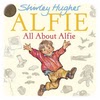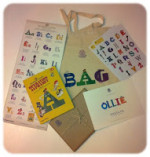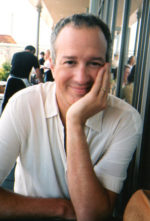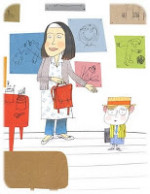Today’s post is really special to me. Unlike many of you, no doubt, I did not grow up with Shirley Hughes’ books as they were not translated in French when I was little. I discovered her work at university, while studying children’s librarianship. I was won over straight away, enchanted by the utter Englishness of her artwork and the timelessness of her tales. My first encounter was with her work was in fact Alfie, before Dogger. When my own children were born, they were introduced to Shirley Hughes’ books and while my daughter was a tiny baby, I would read Annie Rose is My Little Sister to my son, hoping to open his eyes to the ups and downs to having a younger sister. She turned out to be just as willful as Annie Rose!
I am very, very grateful that Shirley agreed to answer a few questions to celebrate 30 years of Alfie, and the release of a new Alfie book, All About Alfie.
Be sure to visit the dedicated website here which includes a wealth of information as well as some activities linked to the Alfie books
Alfie is 30 years-old this year. How did he come about?
I had no idea, when I drew a first quick sketch of ‘ALFIE’ running up the street ahead of his mum, trundling behind with his little sister Annie Rose in the buggy, that he would still be around 30 years later. But I knew he was a promising character, possibly for one book, because he was positively pink in the face to get into the action.
I think one of the reasons Alfie has been so popular over the years is the timelessness of the stories; Alfie’s adventures are as relevant to children 30 years ago as they are to the children of today. How do you choose what the story is going to focus on?
My drawing style is rooted in reality [I don’t do talking animals or flights to the moon]. The ‘ALFIE’ stories spring from those huge challenges like getting your boots on the right feet or going to a party without your security blanket which very small children grapple with. And I don’t think these have change much over the years.
My favourite Alfie story is “Annie Rose is My Little Sister”. Having a son and a younger daughter, I love the book for its emotional, loving and truthful representation of love between siblings. I can’t ever read the last page without shedding a tear. What inspired you to write this particular story?
Annie Rose, like all little sisters, can be trying at times. But I wanted to celebrate the games she and Alfie invent together, and his protectiveness. I do very much want to encourage children to look out, away from all the very powerful electronic stimulation which is coming at them, to enjoy the sky, the moon, leaves, stones, because wherever you live it’s fabulously beautiful out there.
One my daughter’s all-time favourite books is her copy of “My Naughty Little Sister: A Treasury Collection”. Having also written so many of the books you illustrated, how do you approach illustrating those you have not written? How does it differ from illustrating your own words?
I worked as an illustrator of other author’s books long before I started to write my own, and Dorothy Edwards ‘MY NAUGHTY LITTLE SISTER’ stories were a wonderful breakthrough for me. Illustrating is rather like being an actor, stage director, set designer all rolled into one. You have to try to inhabit the audience’s imagination and give it a visual form. It’s a huge challenge and enormously exciting, if you can pull it off.
Where do you work mostly, and have you got a favourite time of day to work?
I wake in the mornings, using natural light especially for colour, and I don’t use a computer.
In 2007,”Dogger” was voted the favourite Kate Greenaway Medal winner of all time and is considered by many, including myself, to be part of a handful of books that every child should own. What is about “Dogger” particularly that makes it so special and appealing to people?
Although all the children in my stories are imaginary [I use a sketchbook all the time as a resource and memory training, but I still use real models] I do use real toys. I came across Dogger in the back of a cupboard one day and he reminded me of that devastating moment when a much loved object is lost at bedtime and its owner can’t possibly get to sleep without it. Dogger is very old now and doesn’t get about much. But this story is really about Dave’s loss and the act of loving kindness with which his older sister Bella manages to rescue the problem.
Which book do you think every child should own?
The Flower Fairy Books, written and illustrated many years ago by Cicely Mary Barker, because I think it’s a great loss if children don’t learn to recognise and know the names of common wild flowers (and not to pick them!)
Do you follow new illustrators and trends in picture book publishing? If so, which books have caught your eye in the last few years?
There are some wonderfully inspiring illustrators currently at work; Chris Riddell, Charlotte Voake, Anthony Browne, Emily Gravett, Jane Rae, Ted Dewan and, of course, my daughter Clara Vulliamy, to name a few.
Finally, if you could choose any book to illustrate, which one would it be?
A collection of English and American songs and nursery rhymes.
Thank you so much again to Ms Hughes for so kindly answering my questions. A special thank you to the lovely Rosi at Random House Children’s Books for making this happen!
All illustrations © Shirley Hughes
Photograph of Shirley Hughes © Kate Peters














We love love LOVE Alfie over here although I think our favorite Shirley Hughes work, if we had to pick one, is Dogger. It is so exciting that you had the chance to interview her! Lucky you.
Wow wow wow Melanie 🙂 Lovely interview indeed. And I’m very pleased to say we just got a big flower fairies anthology last week 🙂
Great interview. It was fun to read her thoughts about Flower Fairies books, which unfortunately I missed reading to my own children. (At least my grandchildren can benefit someday!) Love your blog and will find you on FB.
I have just found your blog as mentioned on Playing by the book blog.
Now following.
I am a fan of Shirley Hughes.
Dogger is very special as it was on the school reading list when I was a teaching assistant.
We love Alfie in our house and I have shared with my eldest children several years ago and am now sharing with my youngest.
carol